
The Scariest Things celebrates Pride Month by looking back at the sometimes awkward but always fascinating role that queer culture has had in horror movies. In a word: Progress.
NOTE: This list has been expanded from 25 to 30 in 2022.
When I was down in New Orleans for the Overlook Film Festival, my colleague Liz Williams and I were talking about potential next podcast episodes, and she reminded me, “Hey it’s Pride Month, maybe we use that as a topic.” I thought that to be a great idea, but as per usual in Scariest Things, I had to do a little bit of background work. There were a couple of obvious films to discuss, and at first, I thought there wasn’t going to be enough to seriously discuss. Boy, was I wrong.
At the risk of being rousted out for being a charlatan (though Mike and I freely admit that we are only sort-of experts), I must admit to the fact that I have to approach this from an outsider’s perspective. I can no more take ownership of Queer Horror as I could for my last list covering Military Horror, for which I have never served in the armed forces. Much as I loved the Shudder documentary Horror Noire for helping non-black audiences appreciate the plight of African Americans in horror movies, the same can be said about my appreciation for Black Horror. I can love this material, but I am inherently an outsider. As a straight man who has seen a bunch of horror movies with LGBT themes, I decided that I should do a little research to uncover what the community thinks is significant.
Portland’s own Queer Horror proved to be an excellent resource, as well as some great articles from Vulture, the Advocate, and Coming Soon helped focus my list, but some pretty big trends became clear, relative to how Hollywood (and the foreign films) handled homosexuality and transgender issues. Some themes really speak to gay audiences, particularly bullying, repression of feelings (particularly love), and the fear of being different. These universal fears are frequently alluded to in horror movies, as they are traditionally outsider’s tales. And, much as the black community had to suffer the indignity of not being represented the way they really wished for, modern films have been making amends for the LGBT community.
In the golden age, and up through the 1960s, homosexual relationships were heavily censored and essentially verboten in film. That didn’t prevent many directors from applying some sub-texts that were suggestive of LGBT themes. James Whale and Val Lewton are regarded fondly in gay film circles for their efforts. In retrospect, critics and scholars have gone back and applied an overlay on many of these films to claim them as queer-positive. It is less clear, as to whether the gay community felt that way at the time of their releases as, well, it was prohibitively difficult to voice your opinions during that more conservative era.
As the Hays code, which we have talked about a bunch in our historical podcasts, began to lose its grip in the 1960s, directors took bigger and more brazen chances on all fronts, and that included LGBT themes. There still was a paucity of really good protagonist roles, and the movies that did flaunt it were usually exploitation fare. Again, this mirrored the Blaxploitation movement of the ’60s and ’70s. And, in keeping with all the grindhouse fare, these films were usually inherently rather trashy, if at times wonderfully entertaining.
The ’80s brought back slick commercialism and progress was stymied, and the queer focus once again slipped into innuendo and sub-texts. Though gays and lesbians were able to live their lives in the open more than in the ’50s, the normalization had not yet been embraced. And, layering in the real-life horror of the AIDS crisis, the expansion of pop culture’s opening of the closet door was, for the moment, paused.
Fast forward to today. As gay marriage and cultural sensitivities have been accepted by a much broader portion of the population, the range of Queer horror types has really expanded. You get some true b-grade exploitation movies, like Hellbent, which strongly resembles a straight horror slasher, along with all the same beats and flaws inherent in a traditional slasher film… just a lot gayer. We also get rich character studies like What Keeps You Alive and Lyle, where the stories involve LGBT characters, but that is only an aspect of the story, they do not focus on the sexual element as much as they are characters in service of a story, who just happen to be lesbians.
Progress! Movies now have the ability to promote homosexual leads in horror films. I suspect they still will be rare, but again, like black cinema with the advent of a movie like Get Out, The old tropes of the minority characters being buddies, sidekicks, or the first person killed are recognized for what they are. Queer Cinema’s critical and commercial success has been in dramas, as it has had huge successes recently with the likes of Moonlight, Dallas Buyer’s Club, Brokeback Mountain, and Call Me By Your Name. I happen to love What Keeps You Alive, and would prop that up as a standard for where Queer Horror can go, but it made no impact at the box office. That is the next big step. The Get Out moment for LGBTQ horror cinema. It’s a unicorn movie. What might be a curious modern turn is that a queer-themed movie would actually elevate the status of a horror film. Such irony! Horror is still at the kid’s table, but LGBT dramatic movies are Oscar bait.
OK, let’s take a look at the history: Not all of these are great films (though most of them are), and not all of them are very generous in their depiction of gays and lesbians but remember… think progress!
POST NOTE: This list has been expanded from 25 to 29 in 2022.
1. The Bride of Frankenstein (1935)

James Whale was an openly gay director, who could not express his lifestyle on the silver screen. Or, at least not overtly. This was a rarity in the Golden Era, and Whale still flourished, producing some of the greatest monster movies of all time through Universal, notably Frankenstein, The Invisible Man, The Old Dark House, and The Bride of Frankenstein. What he couldn’t say directly he alluded to:
- The loneliness of the misunderstood outcast monster.
- The monster is shunned by his created mate.
- The confusion of the Bride, not knowing who she was or why she had been set up.
- The campiness of the film, particularly the wonderfully flamboyant and evil Dr. Pretorius (Ernest Thesinger).
There is something about Mary Shelly’s sympathetic monster that resonated with Whale, that he drew from his life as a gay man in Hollywood, and the history of film is all the greater for it.
2. Dracula’s Daughter (1936)
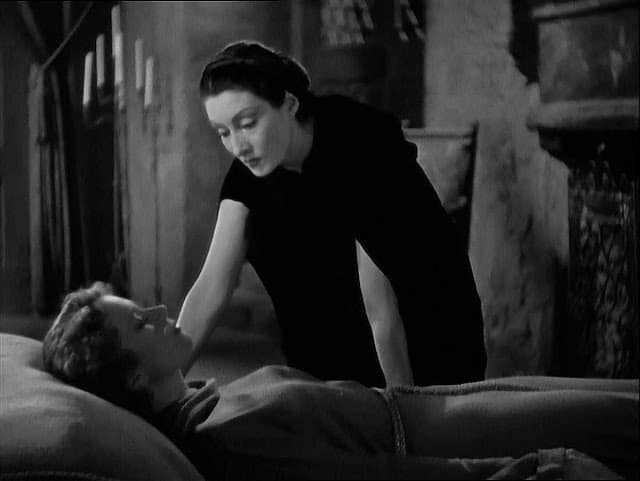
Vampire films are often the vehicle that describes the curse of lust. An insatiable thirst for blood… or other things. With Dracula’s Daughter, the sub-text is fairly clear. The Countess Marya Zelaeska (Gloria Holden) has inherited the curse of Dracula, and her desires to suck the blood of lovely young women have her actually going to a psychologist to treat her of her desires. Ah, nurture vs. nature! That old chestnut, one that has haunted families for generations. Lesbianism = Vampirism = social disease… and therefore there has to be a cure, right? That was Universal’s addition to the movie to help sanitize the sinfulness of it all. Psychology in that era seemed to be something of a cure-all. Remember Cat People? This film has been somewhat lost to the annals of history, but you can rent it on Amazon.
3. The Uninvited (1944)
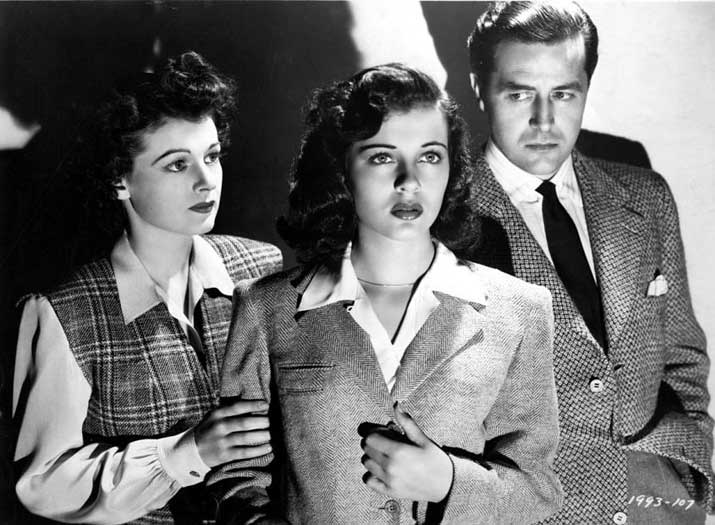
One of the great forgotten horror movies of the 1940s. This was a problematic era for horror films and edgy films of all stripes. The Hayes Code was at its peak, and any suggestions of moral impropriety were quashed. Val Lewton managed to get a pretty damned good ghost story told, in gorgeous shadowy noir, and a gentle portrayal of all the characters. Brother and sister Roderick (Ray Milland) and Ruth (Ruth Hussey) Fitzgerald have purchased a lovely Cornwall estate by the sea, where they become enamored with a young woman, Stella (Gail Russel) who used to live in the home and is still drawn to it, having been forced to depart the building after her mother threw herself off the cliffs nearby.
The home is haunted by not one, but two ghosts who compete for the attention of Stella, her mother’s ghost, and her father’s mistress. Think good ghost/bad ghost, but it is difficult to tell which one is doing the malevolent scheming, and which one is the protector. The overriding mystery of what would have driven Stella’s mother to madness. Perhaps it’s because her husband left her for a Spanish mistress. Perhaps it’s because she was having a lesbian affair with the local asylum matriarch. Hmmm… Another lighter sub-text is the wonderfully independent Ruth, a lovely young professional woman, who doesn’t seem to have any interest in getting married, or men, for that matter. Again… hmmm…
This is a movie on the Criterion Collection and is available through Amazon for streaming. It’s a gentle haunted house movie, very well told.
4. The Picture of Dorian Gray (1945)
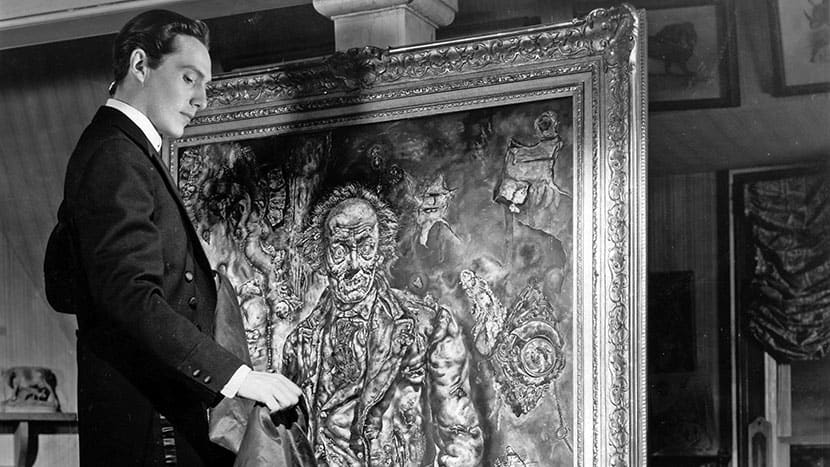
Something inescapable from gay culture is the premium placed upon physical beauty. Raw vanity. Dorian Gray (Hurd Hatfield) is indeed a very handsome and vain man, and quite fashionable in his tuxedo and top hat. Lucky for him, he has made a pact with a cat statue to transfer all of his aging and sins to the portrait that had been commissioned for him. A feline Faustian deal. The film holds very close to the Oscar Wilde book from 1890, continuing a horror trend of utilizing famous works of 19th-century fiction for its source material.
Gray is also a man of bestial sexual appetites, and spends the next eighteen years indulging himself in acts “bestial, sodden, and unclean.” But the portrait absorbs the sodomistic sins, and he is completely unscathed, un-aging, and clear of conscience for his deeds. The portrait now looks like a ghoul. (The portrait from the movie, now famous itself is in the Art Institute of Chicago if you want to see it.) Gray’s actions end up to a series of deaths, one by his hand and a couple by suicide, and one by hunting accident. Eventually, overcome with guilt Grey stabs the portrait, turning him into a withered husk, and reinstating the portrait to a vision of his youth.
Though somewhat tame sounding now, at the time The Legion of Decency decried that “There were portions in the picture which could be interpreted as conveying implications of homosexuality. In light of the code provision “Sex Perversion or inference to it is forbidden.” In this case, the inference was just glancing, but such were the 1940s that something like Dorian Gray would be scandalous.
5. Blood and Roses (1960)

If Dracula’s Daughter strongly hinted at a lesbian vampire subtext, Blood and Roses embraced it. This French film directed by Roger Vadim leaned into the taboo with its marketing materials, and utilizes the Sheridan Le Fanu 1872 novella Carmilla as its source material, as would several movies to come in the emergence as exploitation fare in the 1970s.
Carmilla (Annette Vadim) is distraught that her best friend Georgia (Elsa Martinelli) is getting married to her cousin Leopoldo, who is the ancestor of the vampire Millarca Von Karstein. When Millarca’s crypt is disturbed at a wedding reception, Carmilla assumes the soul of Millarca and turns her attention to getting what she wants out of the upcoming nuptials. Is it Georgia? Is it Leopold? Both? At any rate, she clearly is becoming the classic vampire, scaring dogs, wilting flowers, and of course… desiring blood.
I think this is a strong companion piece to the similarly beautiful and moody Black Sunday from 1960 by Mario Bava. It is a return to Gothic horror and is also representative of the revolution in horror movies in the year 1960, along with Black Sunday, Psycho, Eyes without a Face, and Peeping Tom to push the boundaries of what the code would allow.
6. The Haunting (1963)
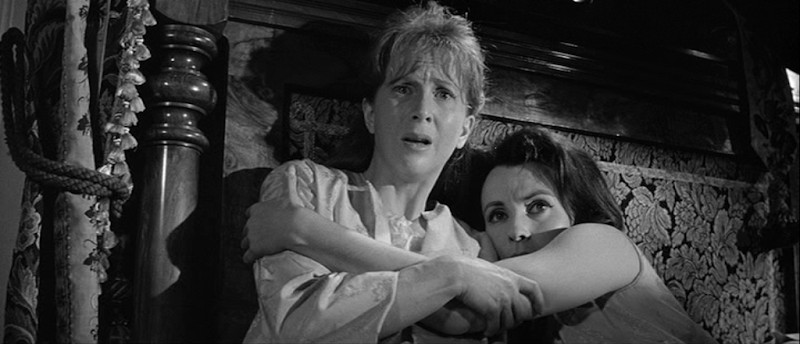
Robert Wise’s masterpiece, The Haunting, of which much has been discussed on The Scariest Things, also happens to feature what may be the best lesbian character ever in horror cinema, in Theo (Claire Bloom), a full-out psychic ghost hunter. She is elegant, smart, confident, witty, and her orientation is not sensationalized. When she and our lead protagonist Elanor end up in the same bed together, it’s for something more primal than sex… fear of ghosts. Or, rather that is the context. Read into it what you will. It is a testament to Wise and writer Nelson Gidding for not hiding Theo’s orientation, making her just another member of the team, and not having that pull focus from the story.
7. Vampyros Lesbos (1971)

Reject the heteronormative patriarchy! It’s the dawn of women’s liberation, and now movies can be explicit about what the new normal is! Ah, who are we kidding… this is soft-core pornography, and really, more erotica than horror. In truth, it’s rather dull by today’s porn-saturated culture. But, at the time, Vampyros Lesbos was a big boundary pusher. Boosted by the lascivious nature of gorgeous women licking and biting each other, it got a fair bit of notoriety when it was released. I wonder if it really appealed to the lesbian community, or, as I suspect, instead the sexy vampiress trope resonates more strongly with straight men. It nevertheless was the most risque of the lesbian vampire trend of the early ’70s, also featured in Daughters of Darkness, The Vampire Lovers, and The Blood Spattered Bride. and all reference back to the work of Camilla.
8. Daughters of Darkness (1971)

Daughters of Darkness is a highly erotically charged and very stylish production that marked the apex of the lesbian vampire film of the early 1970s. Delphine Seyrig is the Hungarian countess who checks into a grand hotel on the Belgian coast, around which a series of child murders have occurred. The countess is, of course, a vampire and she seduces a young British couple, and multiple bouts of sex and violence ensue. Freudian themes get twisted, as parental, gender, marital, and power roles all get twisted and explored. It’s heady horror, even if the behavior logic gets thrown out the window. Daughters of Darkness was B-movie schlock in art-house guise and was an envelope-pushing film at a time when directors would test what the censors would allow.
9. The Rocky Horror Picture Show (1975)

OK. It’s Rocky. The picture says it all. This is a horror movie in name only, using the Frankenstein framework, but otherwise not even trying to elicit any scares. James Whale meets Bob Fosse meets John Waters. This is high-glam sexual freedom at its most ebullient and resonates with misfits and outcasts of all stripes. Still playing at small-art house cinemas like Portland’s Clinton Street theater every weekend, without fail, for fans of at least four generations wanting to do the Time Warp, again.
Priscilla, Queen of the Desert, Moulin Rouge, Barbarella, and Cry Baby may try and make a run at the title of the campiest movie ever, but really, is there any contest? All hail the Queen, baby! The fun wouldn’t last long, however, as it was really a one-movie revolution, and there weren’t successful imitators. (Those previously mentioned excepted.) The AIDS crisis and the Reagan-era moral majority put the lid on exuberant celebrations of queer lifestyle, and sent it back underground, at least in horror movies, back into sub-text, for most of the ’80s.
10. The Hunger (1983)

This is the high water mark for sexy horror movies. It is also the exception to the rule that I stated in my synopsis of The Rocky Horror Picture Show. This is no indie art-house flick, it has real star power invested in this film, with Susan Sarandon, Katherine Deneuve, and David Bowie playing in a bloodletting love triangle. Miriam Blaylock (Deneuve) is a vampire queen, and John Blaylock (Bowie) is her consort, promised to eternal youth as long as he is still in her favor, but she has decided to move on from John, so he desperately seeks the help of Doctor Sarah Roberts (Sarandon) who is a blood pathologist specializing in rapid aging, and she falls sway to Miriam’s powers, and can she resist her sexual allure? (Totally worth watching to find out.)
Tony Scott, no stranger to Gay-positive themes (Hello, Top Gun volleyball), like his brother Ridley, knows how to shoot the hell out of a movie. This feels like a languid music video, with moody lighting, fancy hair, and fashionable wardrobes by Yves St. Laurent, this movie is ready for the runway. It is also a very compact story, and it also has another strong theme running in the fear of aging, and perhaps a fear of AIDS, depending on how you read it. Sexy modern vampires start HERE. Underworld, Blade, Twilight, Lost Boys, get in line. This is the master class in how a sexy vampire movie should look.
11. Sleepaway Camp (1983)

Sleepaway Camp is remembered by most for having one of the biggest shockers in all of horror history. It also is notable for featuring a gay couple raising a family, in this case, young Angela and Peter, only to have tragedy strike and cut down the dad and the son, Peter, in a boating accident, leaving Angela in the hands of an eccentric aunt, which we will eventually find out was not the best idea.
Angela has clearly not recovered well from the trauma when she is sent to Sleepaway Camp with her step-brother. She is extremely shy, and awkward, and struggles with all the issues of a shy and awkward 14-year-old girl, with the additional trauma looming over her. If 80s horror has taught us anything, it’s that kids and teenagers at camp are terrible people. And, they get what’s coming. Bullying, teasing, dating pressure, and even molestation all descend upon Angela. Not surprisingly, she’s not going to take it, and the killings start.
This is all fairly conventional slasher fare up to this point, and the film bears strong resemblances to Friday the 13th and The Burning. And, I would suggest that this is a superior movie to those two, due to the structure and motivation, but it’s all in the same neighborhood. The big twist ending suggests a transphobic freakout moment. In hindsight, you can see the trail of breadcrumbs where this leads, but after all is said and done, it equates being a transgender with madness, or at least that’s the initial take. I think the more realistic take is that bullying leads to madness, but the whole notion of a trans character does not arrive until the end of the movie. So, you’re left to stew in that thinking after the credits roll.
12. A Nightmare on Elm Street 2: Freddy’s Revenge (1985)
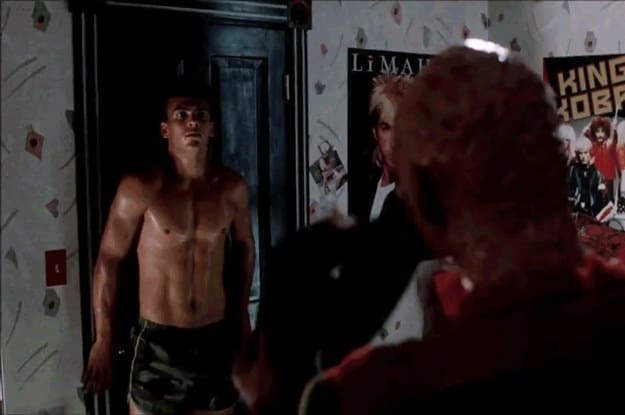
For a long while this had been considered the gayest horror movie ever. And yet, it doesn’t have any out gay characters. Also, this movie sucks. It’s a testament to Robert Englund and the success of Elm Street 3 that the franchise survived. Now, let me be clear, the film does not suck because of the gay overlay, Louis Peitzman at Buzz Feed has a great article about the back story HERE.
Interestingly Mark Patton, who plays the lead protagonist and “Final Boy” Jesse Walsh in a curious twist of the classic final girl trope, is actually a gay actor. But the 80s were a problematic time to come out of the closet still, and he kept it under wraps. However, the screenwriter wrote a very gay-forward script, and only after being gay was de-stigmatized in our current era, did he finally confess that he was steering the story that way.
The bathhouse killing with a towel whipping, and the S&M bar, and the fact that Jesse seems to care more for his buff best friend Ron (Robert Rusler) than his nominal girlfriend Lisa (Kim Myers) plus a couple of doozy lines like “Something is trying to get inside my body!” Well, that put the cards on the table. What is rather stunning is that the director, Jack Sholder didn’t even pick up on the subtext until much later, and you realize the actors, the director, and the writer were all struggling with the production. This film got saddled with being the “Gayest film in horror” when that term was a pejorative. Worthy as a footnote on the path of progress (or a step backward). If you’re looking for a good gay-themed slasher movie try Hellbent (mentioned later) or Pitchfork. This one is just bound to make you uncomfortable for all the wrong reasons.
13. The Fly (1986)

The Fly doesn’t feature any LGBT characters. What it is, however, was the embodiment of the fear of AIDS that was at its apex in the mid 80s as thousands of people were cut down by the disease that at the time could not be stopped, and became the plague of the era. Leave it to David Cronenberg to explore the deepest fears of watching an athletic Jeff Goldblum transform from a being a statuesque icon and devolve into a collection of scales, scabs, and decaying body parts. The film is devastatingly sad and is horrifying to match. Goldblum’s Seth Brundle was an acting job for the ages, and Geena Davis became a star because of this movie. You couldn’t get away from the subtext, because the fear of HIV was all-encompassing, as we watched a generation of gay icons fall to the disease.
14. Hellraiser (1988)
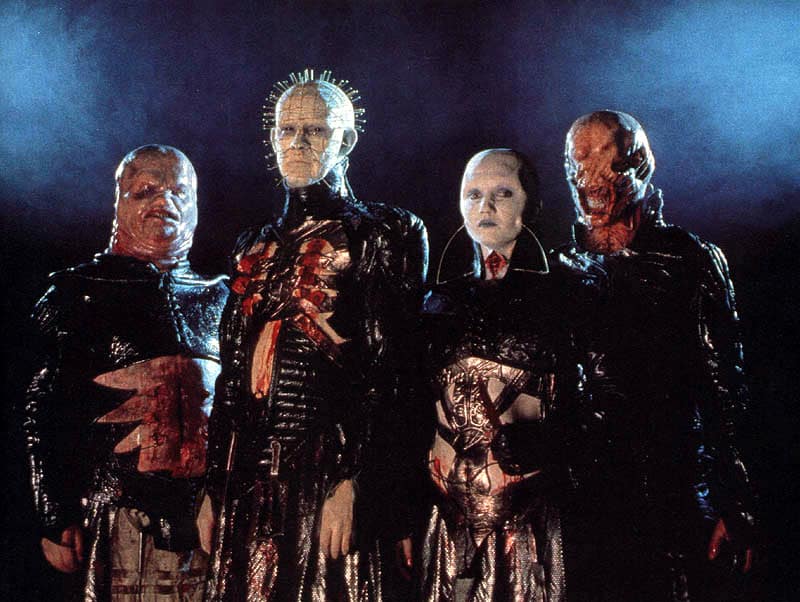
Here’s another metaphor for the AIDS era, and also associating itself with some really kinky S&M bondage wear. Clive Barker, a gay man writing some of the scariest stuff around at the height of the AIDS epidemic managed to equate libidinous desires with a trip to hell. Hellraiser plays with the temptation to the darker side, and it’s full of pain, hooks, nails, and wires. Then again, some people might be into this kind of stuff. I’ve always interpreted it as the path of any sexual desires hetero or homo, that in this era, could be the end of you, and the suffering would be… legendary, or a fun Thursday night.
15. The Silence of the Lambs (1991)
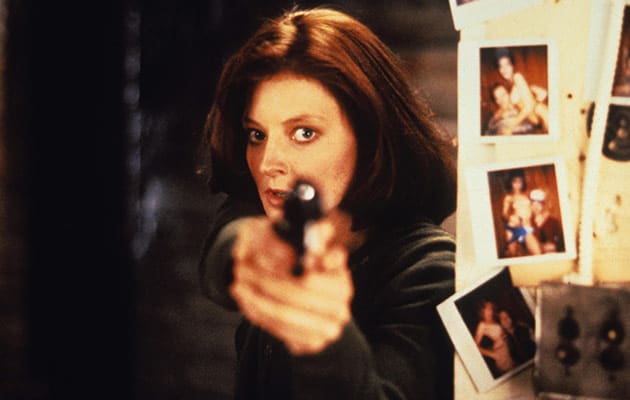
Now here’s an interesting and problematic test case. Take arguably the greatest lesbian actress ever, Jodie Foster, and have her in a career-defining role as Clarisse Starling. She’s a career woman, and I don’t believe she ever discusses her romantic life at all. (No romantic subplots in this movie.) She is everything you’d want in a leading lady, and she won an Oscar for her efforts. Add in the fact that the charsimatic role of Anthony Hopkin’s Hannibal Lecter was based upon a gay cannibal killer Alfredo Bill Trevino, and he too won an Oscar for being the monster we love.
Relative to LGBT representation, however, Buffalo Bill kicked the wasp nest for some in the queer culture. Ted Levine plays the serial killer who wishes to be a woman but because of mental illness has been denied the treatment, so he’s going to extremes to make himself a new body suit. Super scary monster. And, one that rattled the trans community, as it once again, like Sleepaway Camp, made a member of their community into something horrific. So where does the film land, in the balance? Tough call. I still think the movie is masterful. It’s difficult though when you don’t have a trans-positive hero you can point to, in this era to balance the scales, so I’ll have to settle for Jodie.
16. Interview with the Vampire (1994)
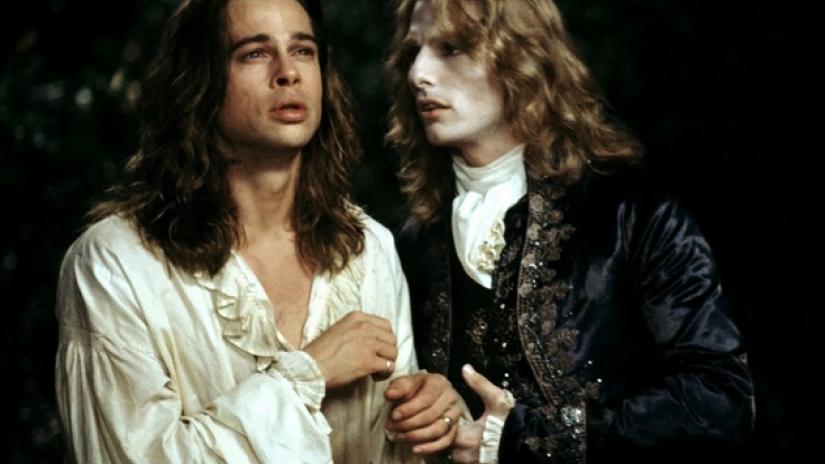
Interview with the Vampire, the famed novel from Anne Rice, features Tom Cruise and Brad Pitt at their peak (though, for these two, their career peak doesn’t seem to have waned) starring as Lestat and Louis, two Vampires with a soul-bonded relationship, with Lestat being the Alpha original vampire, and Louis, the reluctant one who really doesn’t want to hurt anyone. Together, they turn and raise a young girl, Claudia (Kirsten Dunst) saving her from the plague, but cursing her for eternity to be with them.
Sometimes it’s a bit jarring to have two famously hetero men playing gay characters, but Cruise and Pitt, in addition to being movie stars of the first rank, are also pretty good actors and do their best to sell the roles. Anne Rice wasn’t convinced it was going to work. Too famous. Too recognizable. In a 1994 interview with Movieline, she admitted that she wanted her characters more odd and eccentric with actors like John Malkovich, Jeremy Irons, Christopher Walken, and even Alexander Godunov for the roles. But, Warner Brothers believed they needed stars for their production to make money and they stuck to their choices.
Anne Rice never really forgave WB for the decisions they made for the movie version of her book. She is largely responsible for the revival of Gothic vampire sexy, and the whole universe of scheming vampire politics and tribes comes straight from her pen. The movie was lush to look at, as Neil Jordan always has a marvelous sense of stagecraft. The costumes and swampy wonderfulness that is New Orleans were in full effect. In the end, it was a meh movie, but was a rarity for two of the biggest stars in Hollywood playing gay vampiric lovers, and signaled a willingness of Hollywood to have queer go mainstream.
17. High Tension (2003)

High Tension is a horror movie of brute force. The first hour is a masterpiece of tension, as best friends Marie (Cecile de France) and Alex (Maiwenn) on a retreat to Alex’s rural French family home to relax from their college studies. We learn that Marie has stronger feelings for Alex, than Alex may know, but before Marie can make a play on her feelings the house gets besieged by one of the most fearsome slasher villains ever seen. It is a real white knuckle ride, as the stranger grinds through Alex’s family and kidnaps Alex, with Marie in pursuit.
I’ve mentioned this before, but the first 2/3 of this movie is a nearly perfect slasher movie. Smart, REALLY violent, and unrelenting. The plot is pulled as tight as a violin string, and ready to snap at any moment. And then, there is a twist. SPOILER ALERT! (Skip ahead, if you don’t want to know.) It turns out that not only is Marie in love with Alex, but she’s also a psychopath, and it is she who has been the murderer all along. So, we have what may have been a sweet girl, who goes to rescue the object of her desire hero tale, morphing into a story about a girl with violent impulses and unnatural desires. It’s a bit problematic, relative to the LGBT angle. Could they have played this straight? Perhaps. But the angle that you lose is the power imbalance necessary for great horror, which is always the source of great final girl moments. (Eric’s rule #2)
18. Hellbent (2004)

Who needs subtext in the new Millennium? We don’t need no stinking subtext! It just gets in the way! Hellbent is a gay slasher movie, straight up. The protagonists are gay. The victims are gay. And all the context is within the gay community. There’s no fear of coming out of the closet. No bullying issues. No family discovery fears. Nobody is getting killed because of their sexual orientation. It’s just a straight-up big dude in a devil outfit is coming to pick off the cast one by one. The gay guy is the first to die, and so is the second… and so on. Because they’re all gay! Remarkable! The movie is not remarkable apart from the orientation context.
It very much feels like a Halloween sequel, with a big queer filter over the lens. This is a movie that was pitched directly to a gay audience, with winks to the community with moments like one of the characters going in drag to get into disguise (very clever!) and taking refuge in a gay bar, all during the West Hollywood Halloween Carnaval.
19. The Babbadook (2014)

Here’s a curiosity! It’s the accidental queer subtext horror film. This occurred when Netflix categorized The Babadook as an LGBT film by mistake. The grim film about a depressed mother trying to protect her emotionally challenged boy from an imaginary boogeyman doesn’t have any real queer intent. But that didn’t stop the community from adopting it! The themes of depression and anxiety about secrets and closets instantly provided all the reference that was needed. Part of the fun for the community was to re-imagine this very grey film with a rainbow filter.
20. Lyle (2014)
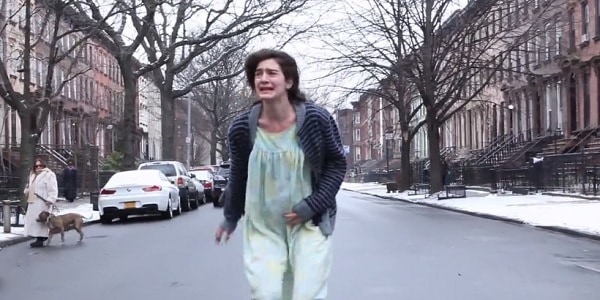
Speaking of grim. Here’s a real punch in the ovaries movie. Another sign that homosexuality is becoming the new normal is Lyle. Leah (Gaby Hoffman) and June (Ingrid Jungermann) play a lesbian couple who are expecting their second child when tragedy strikes the family at the apartment they just moved into, as their toddler Lyle dies in a seemingly preventable accident. Fast forward a few months when Leah is now late into her pregnancy, and like Rosemary, begins to suspect that something is not right about the apartment, or their neighbors, or the pregnancy… and Leah is on the verge of emotional collapse. The odd and subtle situations keep arising, and soon the audience begins to share Leah’s fears. Are we witness to something sinister, or are we seeing it through Leah’s madness?
The biggest selling point for this short feature is its plausibility. The recklessness and precariousness of infants. And the normality of Leah and June’s relationship. These are not your lipstick lesbians, these women resemble the lesbians who I know, and it anchors the relationship for me. Moreover, it is about the situation, and the relationship is just one component of the film. Interestingly, the creeps all happen in bright daylight. The movie effectively layers the creeps, to be sure.
21. Let the Right One In (2016)

Back to subtexts! Oskar (Kåre Hedebrant) is a frail little boy constantly being bullied by his schoolmates. And he finds the ultimate companion in Eli (Lina Leandersson), a vampire trapped in the body of a young girl. It is a movie both externally cold, and internally warm. Eli, while at the same time sending her minion out to collect blood from Stockhom natives, becomes curious about her new pale little friend, and becomes his willing protector. Oskar, desperately wanting a friend, is willing to look past all of the warning signs and even asks Eli to be his girlfriend, whereby Eli responds that “I’m not a girl.”
Now, you can read that as “I’m not a girl, I’m a century’s old vampire.” Or, you can read the subtext as “I’m not going to apply a gender role to myself.” And yet, it is the friendship that resonates, and Oskar doesn’t mind… girl, boy, or whatever. Good thing too, because she’s a lot more powerful than those bullies. Powerful statements in subtle gestures.
22. Raw (2016)
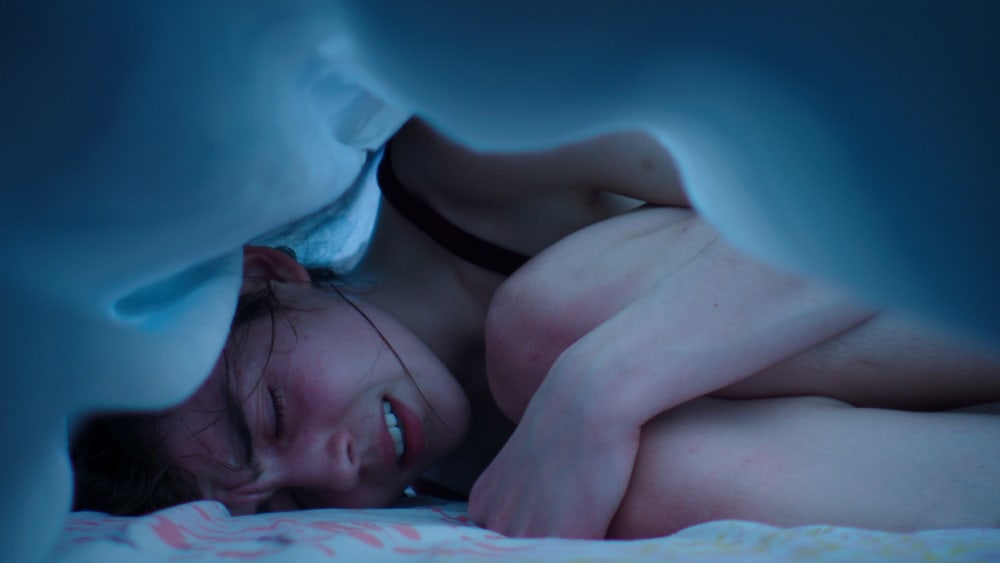
For my money, Raw is one of the great horror movies of the last decade. It’s about as emotionally uncomfortable as a movie can make you feel. And it is one of those movies where the protagonist is the monster and you absolutely fall in love with the lead, Justine (Garance Marillier), a young vegan veterinary school student who through a school prank is forced to eat a rabbit’s kidney, and then starts to desire… human flesh.
There are some overt LGBT elements, like Justine’s gay best friend Adrien (Rabah Nait Oufella), and the overly sexual relationship that Justine has with her more outrageous sister, Alexia (Ella Rumpf). There are also the subtexts about uncontrollable desires and appetites, and holding secrets from everyone around you that resonate as well. Where vampirism and the sucking of blood is now fairly quaint, the consumption of someone else’s flesh is considerably more taboo.
23. B&B (2017)
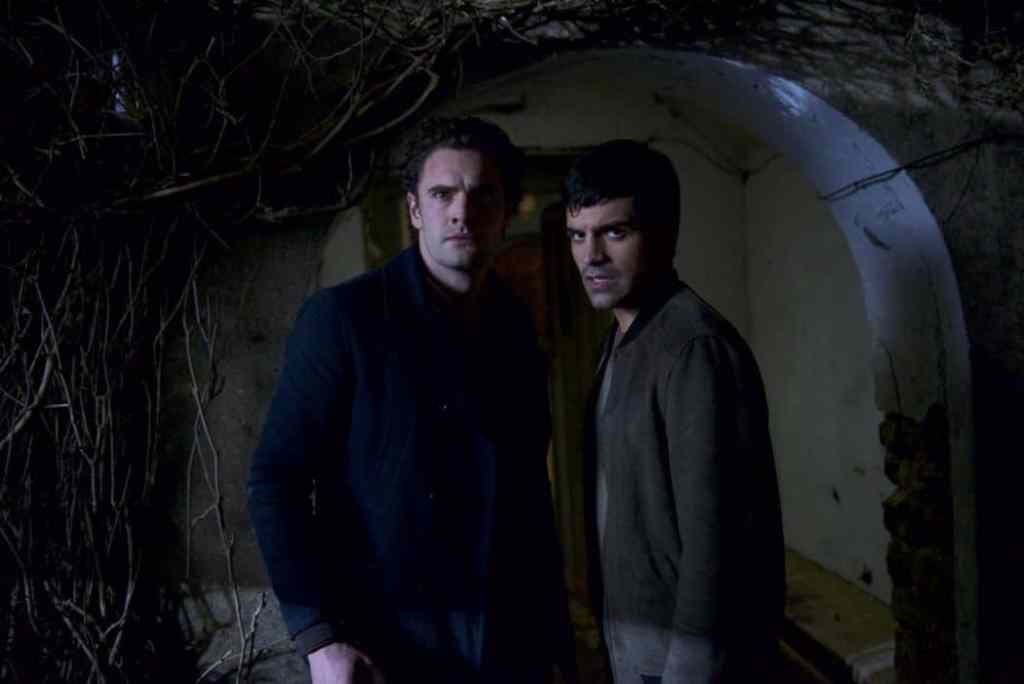
B&B explores the frustrations of the gay community in pushing back against the corners of society that have yet to accept the institution of gay marriage and queer culture in general. Marc and Fred are refused a room in rural England because of a Christian innkeeper’s prejudices. When they get rewarded with a court injunction, their triumphant return becomes far worse than being merely refused a room as another hotel guest arrives with malice and terror in mind. An extra layer to the story is that the son of the closed-minded innkeeper is a young man struggling with his identity and who fears coming out to his unforgiving father. B&B is a bit patchy with its pacing, but it tackles concerns about the evolution of queer fears and the frustrations of the ongoing battle to educate and gain acceptance, even in a more modern world.
24. What Keeps You Alive (2018)
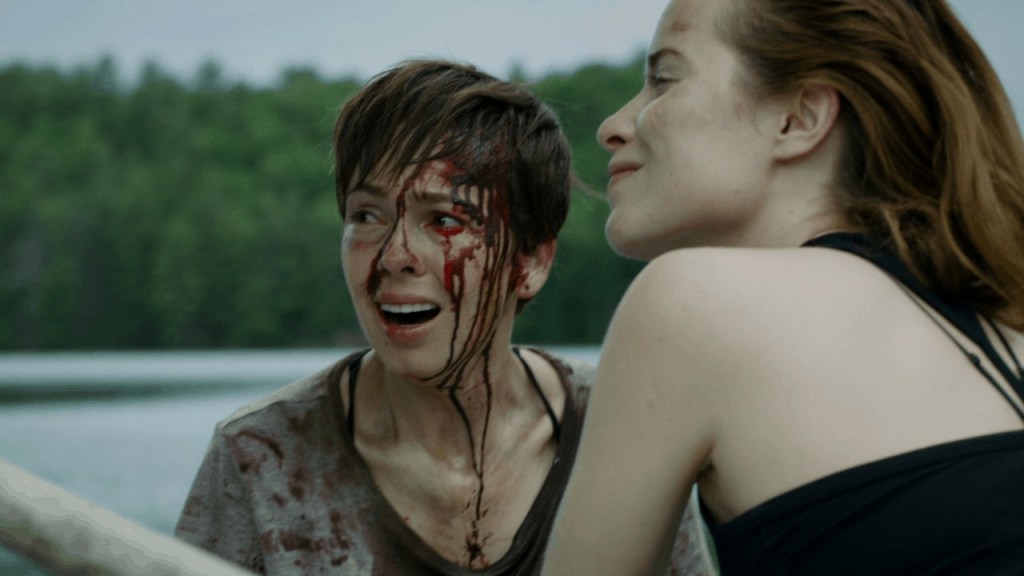
What Keeps You Alive is the story of a lesbian couple Jackie (Hannah Emily Anderson) and Jules (Brittany Allen) who are celebrating their one-year anniversary by taking a trip to a remote island CABIN IN THE WOODS, where they can relax and enjoy some peace and quiet. Things unravel, however, when someone recognizes Jackie, calling her by another name. Soon, Jules comes to realize that Jackie has been leading a double life, and the side that she didn’t know is psychotic and homicidal.
The beauty of this story is that both the heroine protagonist, Jules, and the crazy villain are both lesbians. So, it’s equilibrium on the representation side. Like Lyle, this is just the tale of a couple, and though the “Oh my God, my spouse is going to kill me!” is a well-worn path, this may be a first in queer horror. Seeing how, well, gay marriage is a fairly new institution. That aside, what makes this an interesting dynamic, is that though Jackie has the factor of surprise (and madness) in her favor early in the story, once Jules gets her wits about her, it becomes a level playing field thriller. Good stuff! It wasn’t big at the box office, but it certainly deserves to be a cult classic, it’s a beautifully shot film and a first-rate thriller.
25. Lizzie (2018)
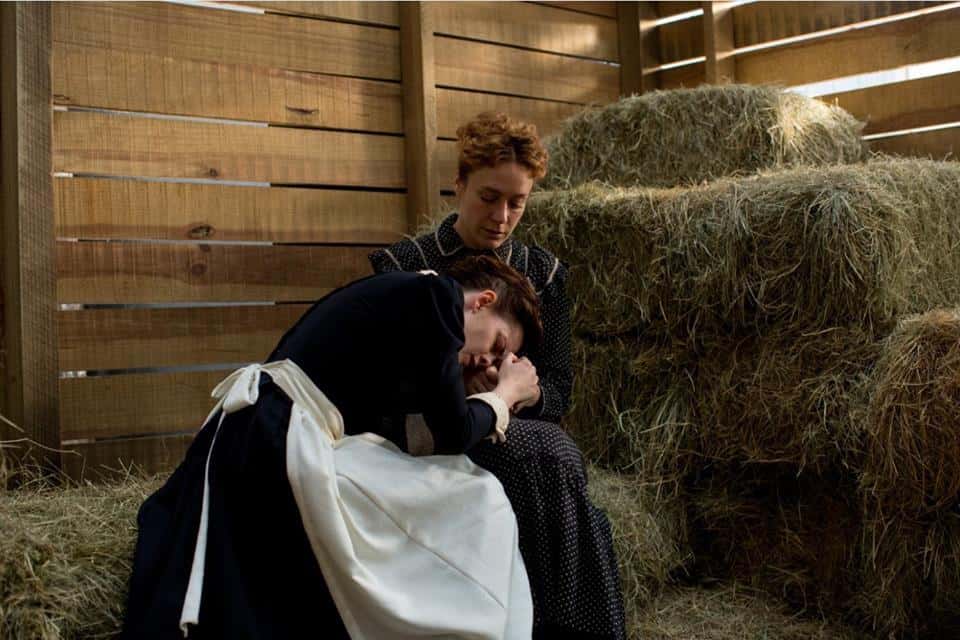
A lesbian horror biopic! And this is a story that you might actually be familiar with. Lizzie Borden’s axe-swinging rampage gets a bit of back-story here, with this re-imagining of a true tale. Lizzie (Chloe Sevigny) and her new servant Maggie (Kristin Stewart) have fallen in love in stuffy 1897 New England. Not the easiest era to be out of the closet. But that doesn’t stop them from having a passionate romance. Add in a full dose of meddling patriarchal misdeeds, and greedy machinations, and… it’s time to bring out the axe! Choppity Chop Chop! Does a period piece enhance or diminish the impact of the queer relationship? One thing that it does do is place the characters in a position of social peril due to the era it takes place in.
In the 1890s the stakes for the relationship in that era would have been severe for sodomy, but for a modern filmgoing audience, the mere idea of a queer romance is now rather vanilla. So the risk to the characters is much greater in a period piece. Now comes the tricky part, the same rules apply for homosexual as for heterosexual relationships on film… you still need a great story, with a great script, with great acting and then it will be noteworthy. Here’s to the new normal!
26. Bit (2019)

Bit goes places that The Craft (1996) only suggested. Knocking down any notions of subtext, this is a movie that is an out and proud lesbian vampire movie. It’s a gender-swapped Lost Boys without any pretense. A young woman travels from a closed-minded small-town for the anonymous security of Los Angeles, where she joins a coven of young vampires, who are a self-described group of terrorists and a specific code to adhere to. It’s safety in numbers, so long as everyone sticks to the code. This movie also provides a significant cultural milestone by casting a transgender young woman, Nicole Maines, as the lead in the movie.
27. Spiral (2019)

The continued acceptance of gay marriage and gay families in American culture is reflected in the movies, but it doesn’t mean that society has cleared all its prejudices and emotional hurdles yet regarding the full acceptance of the gay family unit just yet. Spiral puts the changing dynamics into a horror concept by placing Malik and his family in a small town where perceptions of trust and acceptance collide with a homophobic cult. Culture has come a long way, but there’s still a long way to go, and Spiral picks on those fears of partial progress.
28. Sissy (2022)
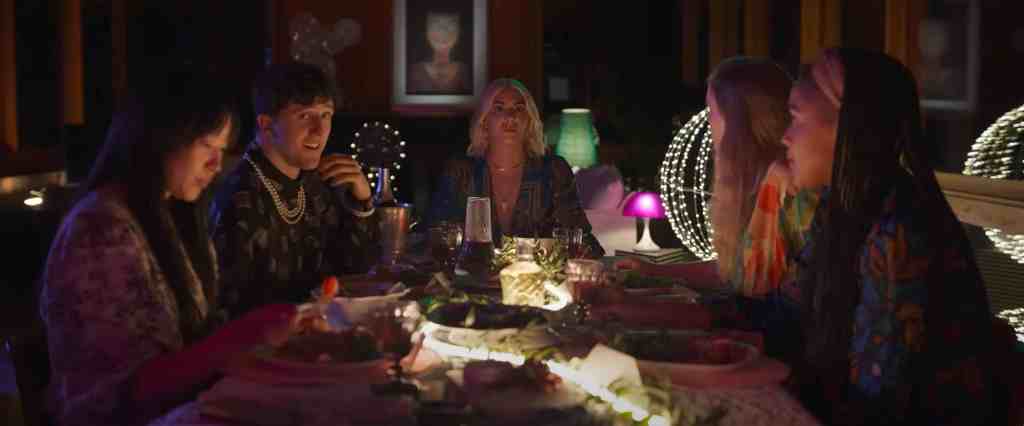
Sissy is peer pressure horror. And, though it could have been about any social circle, this film involves a clique of gay and lesbian friends who congregate for the engagement of Emma and Fran, while watching our main protagonist Cecelia (Sissy) who was childhood best friends with Emma struggle with the outing, clearly still has feelings for her old but now socially distant bestie. This is about social power dynamics within a very bitchy and catty group, (classic queer snarkiness) and how the casual teasing and dismissal of Sissy leads to some horrific ends.
This is a very uncomfortable watch, as it is hard to get behind our put-upon protagonist as she resorts to some fairly lame self-help attempts of meditation. The social dynamics are so awkward, so cruel, that the inevitable violent snap that comes at the end has some satisfying revenge elements until you check your own emotions and realize that the reaction far outweighs the instigating verbal barbs. It is a very Millennial-centric horror movie, with cyberbullying and direct bullying at the core of the story. It has been a big hit on the festival circuit, having won the audience choice award for the Overlook Film Festival in 2022, and premiering at SXSW.
29. Hypochondriac (2022)

Hypochondriac places a young gay man, Will (Zach Villa) at the center of a trippy psychological potboiler thriller. Will has seemingly successfully survived the trauma of nearly being killed by a schizophrenic mother when he was a child, but mysterious packages and messages from his mother trigger haunting PTSD hallucinatory nightmares upon him as an adult. Have the awful psychoses of his mother been passed down to him genetically, or perhaps he shouldn’t have consumed the magic mushrooms that his mother left behind. Either way, it is a riveting and revealing story of mental health at a time when many of us could use some counseling.
30. Swallowed (2022)

Saving perhaps the best, or at least the scariest, Queer horror film for the most recent in the list, Swallowed ventures and explores subject material that others would only hint at. Director Carter Smith (The Ruins) delivers a story of a young man who is destined to be a gay porn star and his childhood best friend who, in trying to send him to LA with a generous goodbye gift ends up putting both of them into mortal danger in a deal gone very, very wrong. It’s a compact but impactful little film that delivers thrilling body horror with the underpinnings of great character and acting moments. It manages to be both poignant and brutal and is a welcome return to the genre by Smith.
You can check out our interview with Carter Smith on our Podcast Extra from the Overlook world premiere of the film HERE. Or, check out the podcast on iTunes, Stitcher, Google Play, or however you stream your podcasts!

